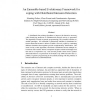Free Online Productivity Tools
i2Speak
i2Symbol
i2OCR
iTex2Img
iWeb2Print
iWeb2Shot
i2Type
iPdf2Split
iPdf2Merge
i2Bopomofo
i2Arabic
i2Style
i2Image
i2PDF
iLatex2Rtf
Sci2ools
GPEM
2010
2010
An ensemble-based evolutionary framework for coping with distributed intrusion detection
A distributed data mining algorithm to improve the detection accuracy when classifying malicious or unauthorized network activity is presented. The algorithm is based on genetic programming (GP) extended with the ensemble paradigm. GP ensemble is particularly suitable for distributed intrusion detection because it allows to build a network profile by combining different classifiers that together provide complementary information. The main novelty of the algorithm is that data is distributed across multiple autonomous sites and the learner component acquires useful knowledge from this data in a cooperative way. The network profile is then used to predict abnormal behavior. Experiments on the KDD Cup 1999 Data show the capability of genetic programming in successfully dealing with the problem of intrusion detection on distributed data.
| Added | 25 Jan 2011 |
| Updated | 25 Jan 2011 |
| Type | Journal |
| Year | 2010 |
| Where | GPEM |
| Authors | Gianluigi Folino, Clara Pizzuti, Giandomenico Spezzano |
Comments (0)

